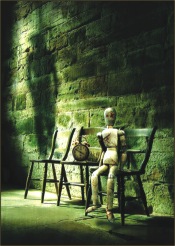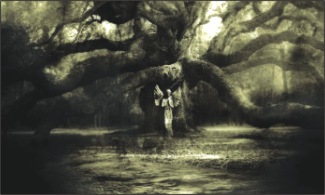The
Children of the Night
 By
You should know who
By
You should know who
Sink
your teeth into the darkness as the Rising Stars pays homage to all
the children of the night.
The
Wolf Man
ly-can-thro-py (n.)
n folklore, the magical ability to assume the form and characteristics
of a wolf.
A delusion that
one has become or assumed the characteristics of a wolf or other animal.
The
Wolf Man is the most violent and primitive of the Monster Squad. He
originally emerged as a fairy tale to warn men of the rage that lies
beneath, and soon became a favourite bedtime story character. He appeared
in comic books and pulp novels before becoming one of the most popular
monsters, hot on the heels of Dracula and Frankenstein.
You know the tale: If someone is bitten by a werewolf, they become
a werewolf themselves at the next full moon, and they can only be
killed by a silver bullet or stab. Everyone likes The Wolf Man - even
Michael Jackson appeared as one in extended video for "Thriller".
The
Mummy
The Mummy is a bit cursed himself as a monster compared to flashier
siblings like Dracula, Frankenstein's Monster and The Wolf Man. Once,
the Mummy was frustratingly limited as both an icon and as a threat
to humanity. Sure, the ability to curse people is pretty cool, but
the Mummy was also a bit slow and dim-witted, usually without the
towering height and physicality that worked to the advantage of Frankenstein's
Monster.
The Mummy was
also limited in terms of different storylines. Again, there was only
so much you could do with the basic structure: foolish humans, whether
they be archaeologists or any variation on such a profession, unearth
the Mummy's tomb and awaken him. They are then cursed and terrorized
by the lumbering undead whose mode of communication usually consists
of just moans and groans.
However, as a
visual icon, the Mummy works beautifully as a horror character. There's
something unnerving, as always, about the dead coming back to life,
and the fact that you usually can't completely see the Mummy's face
- most of it hidden behind decaying bandages - creates a further sense
of dread and mystery. There's also something terrifying about the
concept of the Mummy's curse - since the specifics of the curse are
usually never revealed, you have no choice but to wait to see what
happens to you. The Mummy's somewhat understated methods - the muttered
curse, the slow gait, the moans and groans - make him perhaps the
most subtle monster, and the creepiest on a psychological level.
Frankenstein
Mary Shelley's Frankenstein, or the Modern Prometheus
is one of the most well known horror and science fiction novels in
the history of literature. Frankenstein, or rather "The Creature",
is one of the most familiar icons in modern pop culture. The story
of a doctor who creates a monster from the pieces of corpses has fascinated
and thrilled readers and audiences for almost 200 years, appearing
in films, comics, games and even the occasion TV commercial involving
chocolate bars.
The story of Frankenstein
affects us on a moral level, providing a cautionary tale about the
dangers of toying with science and trying to manipulate the natural
cycle of life and death. More importantly, it also affects us on a
psychological and visceral level, as the Creature is a prime example
of the monstrousness that man himself is able to conjure. Truly, the
Creature has always been a tragic figure - at its heart, the Frankenstein
story is about a father and the son he rejects. The story is devious
in its simplicity and thrilling in its ability to continually scare
us with the idea that we could be capable of initially justifying
such a horrifying creation.
 Zombies
Zombies
A zombie is a dead person that is brought back to life through a curse
(voodoo, necromancy) or a mutation and has recovered some vital functions
like movement. They are near-mindless, possessing little reasoning
power, though many can perform "remembered behaviours" from
their mortal existence.
Zombies are not
that popular. That's probably because they are not easy to get rid
of. If a Zombie starts lumbering towards you, all you can do is run
away screaming. Shoot it, no effect. Set it on fire, no effect. Drown
it, no effect. Whatever you do, it'll just continue to come after
you… until it catches you. And they are very slow, which ruins the
climax.
Zombies have been
confused with many other monstrous creatures. Some zombies have the
appearance of the living but their lack of free will and souls give
them the appearance of mechanical robots. Other display visible signs
of waterlessness, decay and bony-ness on their face and body. They
have blank, expressionless faces that become more animated when they
get hungry and engage in a feeding frenzy.
They are incapable
of speech, but often tend to make moaning and guttural sounds. They
are normally encountered wearing whatever clothing they wore in their
human life, prior to reanimation.
The
Vampire
Dracula is arguably the most popular creature in this monstrous article.
The centuries-old vampire who pretends to be a Transylvanian count
has made the most appearances in film, games, comics, and on stage.
The immortal monster is condemned to walk the earth for eternity,
his story and striking personality forever burned in pop culture and
our subconscious.
Dracula's popularity
stems not only from our fascination with the vampire myth but with
his almost completely human appearance. He is a suave, seductive,
charming beast, anxious to bring out the hunger and potential evil
that lurks inside his victims even before he's made contact with them.
His flowing black cape and ability to change forms makes his eternal
journey through the darkness look strangely appealing. He is also
the most tempting of all the monsters, with his hypnotic voice and
ravenous craving for human blood promising that a life of living hell
might actually be one of the most sensual experiences one could ever
experience.
